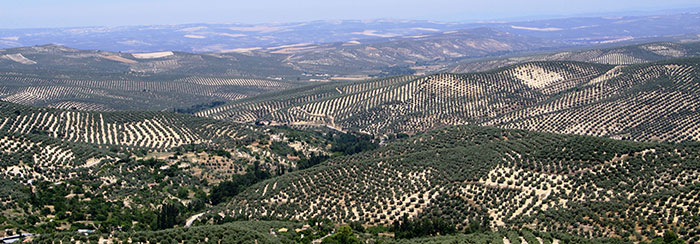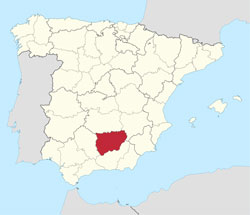Jaén in Jaén

The province of Jaén is the third biggest province of Andalucia with an area of 13,484 km2 and it borders the provinces of Ciudad Real. Albacete, Granada and Córdoba.
The highest point in the province is Pico Mágina in the mountain range of the same name. It is 2,165 meters above sea level and has a prominence of 1,135 m.
Jaën is one of the less known provinces of Spain, mainly due to its lack of coast line and beaches, which makes it a less attractive destination to sun and sea tourists. Nevertheless, the province has a lot going for it, and it is becoming an increasingly sought destination for rural and cultural tourism.
It is home to four national parks apart from many other protected natural areas. In fact the Parque Natural de Cazorla, Segura y las Villas is Spain’s biggest national park and the second biggest in Europe.

The province is also the home to the largest concentration of castles in the world outside the Levant. This is due to its important strategic position during the Reconquista. In Jaén you will also find two Renaissance cities, Baeza and Ubeda, which have both been declared World Heritage Sites by UNESCO.
And as if all that was not enough to claim fame, the province is the world’s largest producer of olive oil. It boasts more than 66 million olive trees on 550,000 hectares and it produces on average 600,000 tonnes of olive oil a year. This is almost 50% of the total Spanish production, and 20% of the world production.
The province of Jaén is home to 638,099 souls, 113,457 of whom live in the capital of the same name. Jaén has another name, a very apt nickname: the World Capital of Olive Oil.
The city is a capital little known by travellers who pass it by on their way to the coast. But they lose out on one of the most interesting historic quarters in Andalucia. At the foot of the Santa Catalina mountain nestles the old Arabian Jayyãn, as they called it. It was constructed on the site of the old Roman and Visigoth towns, which again had been constructed on top of an old Iberian settlement.
The city is surrounded by fertile farm land planted with olives. Towards south and southeast you can see the mountain ranges of Sierra de Jaén and Sierra de Jabalcuz. To the north the plain of the River Guadalbullón opens out and the river passes close by the city.
Olive oil production and distribution are the largest contributors to Jaén’s economy, but also the services sector, administration and production and distribution of other food stuffs play an important part. Furthermore, income from cultural tourism is growing.
Some of the most important and famous sights the city offers are the Assumption of the Virgin Cathedral, the castle and the Arab baths.
The plans for the cathedral were conceived in the 16th century as a replacement of the Gothic cathedral that had occupied that space earlier. The construction took several centuries, but in spite of this, the original plan was followed to the T, and the result is the impressive building that dominates the Jaén cityscape.
The castle actually consists of three parts: Alcázar Viejo (the old fortress), the Santa Catalina Castle and the Abrehui, the most recent addition. The three fortresses formed our large walled citadel which was used both as a fortification and living quarters. It was last populated in the 17th century, since then it has been empty.
The Arab baths are situated underneath the Villardompardo Palace. With a surface of 450m2 they are the largest conserved Arab baths in Spain. They were originally constructed on the site of an old Roman bath. More than 55,000 people visit the baths every year.
The winters in Jaën are mild and the summers very hot and dry. The largest amount of rain falls toward the end of the autumn.


